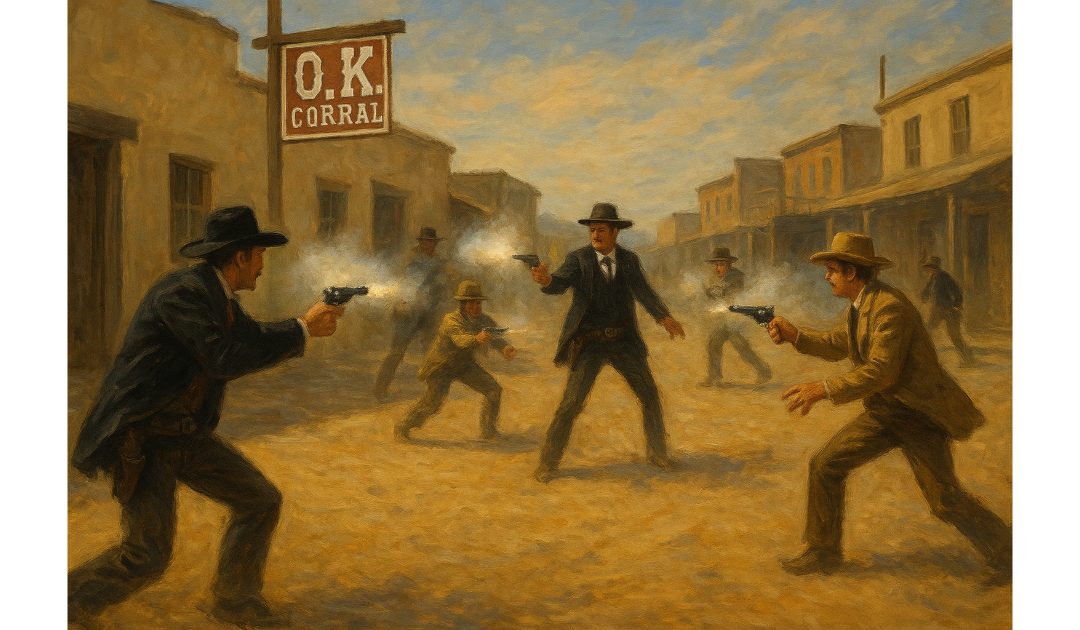The gunfight at the O.K. Corral was fought on the 26th of October, 1881. My father loved Westerns, and they were pretty much the only books he would read. So I rather grew up watching a lot of westerns, although my reading was much more varied. The gunfight at the O.K. Corral is one of the most iconic events in the history of the American Old West, symbolising the lawlessness and rugged spirit of the frontier. This brief but deadly confrontation took place in the town of Tombstone, Arizona. It involved lawmen Virgil, Wyatt, and Morgan Earp, along with their associate Doc Holliday, squaring off against the outlaw Cochise County Cowboys, a loosely organised group led by Ike and Billy Clanton, and Tom and Frank McLaury. The gunfight itself lasted a mere 30 seconds but left a lasting legacy in American folklore.
Background and Tensions in Tombstone
Tombstone was a booming silver mining town, attracting a mix of prospectors, entrepreneurs, gamblers, and outlaws. The Earp brothers arrived in Tombstone seeking opportunities, with Virgil serving as the town marshal. Wyatt Earp, known for his previous law enforcement roles, sought political influence and business ventures. The Cowboys, on the other hand, were known for cattle rustling, stagecoach robberies, and other criminal activities.
Tensions between the Earps and the Cowboys escalated due to their opposing roles—lawmen versus outlaws. The town was divided between those supporting law enforcement and those sympathising with the Cowboys. Disputes over cattle theft, stagecoach robberies, and political influence created an atmosphere ripe for conflict. Ike Clanton, in particular, harboured a deep resentment towards the Earps, leading to frequent public threats and confrontations.
The Events Leading to the Gunfight
On the 25th of October, 1881, Ike Clanton spent the day drinking heavily in Tombstone, making threats against the Earps and Doc Holliday. His behaviour alarmed the townsfolk, and tensions were palpable. The following morning, Ike was armed and still making threats. Virgil Earp disarmed and arrested him for carrying a weapon in town, fining him $25.
Meanwhile, Billy Clanton and the McLaury brothers arrived in town, learning of Ike’s arrest. They armed themselves and joined Ike, determined to confront the Earps. The Cowboys gathered near the O.K. Corral, an empty lot behind the Corral itself, armed and ready.
Virgil Earp decided to intervene before violence erupted. He deputised Wyatt, Morgan, and Doc Holliday, and the four men approached the Cowboys to demand they surrender their weapons peacefully.
The Gunfight
At around 3:00 PM on the 26th of October, the Earps and Holliday confronted the Cowboys near the O.K. Corral. The exact sequence of events is debated, but it’s generally agreed that Virgil Earp ordered the Cowboys to disarm. A tense standoff ensued, with both sides exchanging heated words.
Suddenly, gunfire erupted. Historians disagree on who fired the first shot, but once it started, it was relentless. Despite the brevity of the fight—lasting about 30 seconds—nearly 30 shots were fired. Tom McLaury, unarmed according to some accounts, was shot and killed. Frank McLaury and Billy Clanton, both armed, died from multiple gunshot wounds. Ike Clanton managed to flee, escaping unharmed.
Wyatt Earp emerged unscathed, while Virgil and Morgan sustained injuries. Doc Holliday suffered a minor wound. The deadly confrontation shocked the town and marked a turning point in the power struggle between lawmen and outlaws.
Aftermath and Legal Proceedings
The aftermath of the gunfight was tumultuous. The Cowboys and their supporters accused the Earps and Holliday of murder, claiming the Cowboys were attempting to surrender when shot. The Earps defended their actions as necessary law enforcement.
A month-long preliminary hearing ensued, overseen by Justice of the Peace Wells Spicer. Testimonies from both sides painted conflicting narratives. Spicer ultimately ruled that the Earps and Holliday acted within their duties as lawmen, and no charges were filed. However, public opinion remained divided, and the violence continued.
The Cowboys sought revenge. In December 1881, Virgil Earp was ambushed and severely wounded, leaving his arm crippled. In March 1882, Morgan Earp was assassinated while playing billiards. These attacks prompted Wyatt Earp to embark on a vendetta ride, seeking justice for his brothers. He and his posse tracked down and killed several Cowboys believed responsible.
Legacy and Cultural Impact
The Gunfight at the O.K. Corral became legendary, symbolising the struggle between law and order and the chaos of the Wild West. Its portrayal in books, films, and popular culture often romanticises the event, emphasising themes of bravery, justice, and revenge.
Wyatt Earp’s later years contributed to the myth. He lived into the 20th century, sharing his story with writers and filmmakers, ensuring his version of the events endured. Doc Holliday’s image as a charismatic, deadly gambler also fascinated the public.
Movies like “Tombstone” (1993) and “My Darling Clementine” (1946) solidified the gunfight’s place in cinematic history. Each adaptation adds layers to the legend, blending fact and fiction.
Conclusion
The Gunfight at the O.K. Corral was more than a shootout; it was a microcosm of the broader conflicts in the American frontier. It highlighted the volatile mix of law enforcement, crime, politics, and personal vendettas. While the real story is complex and nuanced, its enduring legacy speaks to humanity’s fascination with tales of courage, conflict, and the quest for justice.

